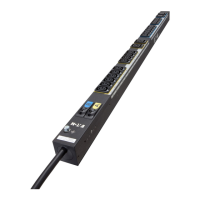NOTE For FTP operation, FTP must be enabled (default setting) in the Web pages
(Network > Security > Global > FTP enable).
Maintenance and Alarms
Eaton ePDU G3 Operation Manual P-164000277—Rev 1 www.eaton.com/ePDU 129
18. Open a DOS command window on a computer that is also connected to network.
19. Change directory (CD) to the location of the XML file.
20. Open an FTP session using the following command:
>ftp <IPaddress>
where <
IPaddress> = the IP address displayed on LCD
21. Type the default login and passw
ord (“admin” and “admin”).
22. At the command prompt, type the following command:
>cd config/hw
>dir
23. If an XML file already exists, type the
following command to delete the XML file:
>delete <con
fig file>
24. To upload the configuration file to the eNMC module, type the following command:
>put <config
file>
where <config file> = the file name to be downloaded to the eNMC module
NOTE Keep the <config file> name exactly as it is downloaded from the website. In
particular, it must begin with the prefix “epdu_cfg_” or the eNMC module will not
recognize it.
25. Type the following command and ensure that the new file exists:
>dir
26. Type the following command to quit the FTP session:
>quit
27. Go to “Reboot the eNMC Module and Reset the ePDU” on page 130.
28. Connect the USB device with the uploaded hardware configurtion file to the ePDU that has just has the
eNM
C.
29. Using the LCD display, follow the procedure to “Lo
ad the eNMC Configuration File from the USB” on
page 54.
30. Go to “Reboot the eNMC Module and Reset the ePDU” on page 130.
NOTE To perform the eNMC configuration upload with USB, only one hardware
configuration file must be stored in the USB key.

